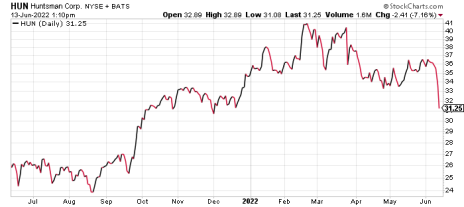One factor that has kept inflation from spiraling out of control is that the dollar has become something of a safe haven for investors in an otherwise tumultuous financial market. When investors worldwide liquidated assets in recent months, they ran to the dollar—one of the few strong currencies of 2022.
That paradigm appears to be shifting, however, as the dollar’s soundness is now being questioned by some investors. In fact, according to JPMorgan Chase, currency volatility has returned with a vengeance. The Wall Street Journal reports, “An index measuring swings in currencies linked to the Group of Seven countries has jumped as high as 80% this year.”
[text_ad]
WSJ pointed out, for instance, that euro currency volatility has more than doubled since November and has accelerated since March. (It should be noted that foreign exchange volatility increases when currencies quickly lose value.)
After a rapid surge between March and mid-May, the U.S. dollar index (DXY)—which measures the dollar against a basket of currencies—has recently lost momentum.
Assuming the dollar continues to weaken, many observers believe it would cause the domestic inflation rate to increase even further. After inflation recently hit a 40-year high, the last thing consumers need is even higher prices for goods and services.
In any case, it’s not likely that inflation will disappear anytime soon, which means investors should continue hedging against it. Below are two stocks and an ETF that should benefit not only from continued inflation, but from increasing currency volatility.
3 Ways to Hedge Against Currency Volatility
Fluor (FLR) is a leading engineering firm, providing construction, maintenance and project management services for the oil and gas, industrial and infrastructure and power generation (including nuclear) industries. The company also offers process expertise in metals and mineral mining, including for gold, copper, coal, nickel and uranium and provides support for fertilizer producers. In other words, it has a broad range of exposure to several inflation-sensitive segments of the global economy. As such, it tends to benefit from a weak dollar environment.
Fluor also owns a 57% stake in a power company that markets small modular nuclear reactors for communities across America, giving it additional exposure to the lucrative alternative energy market. Management has indicated that dividends and share repurchases are possible as the firm builds its backlog and improve the quality of earnings in cash generation.
Another segment of the economy that should benefit from currency volatility is the steel industry, which is currently in the midst of a high-growth phase. Record demand from the automobile, construction and appliance industries have, for instance, prompted top steelmaker U.S. Steel (X) to guide for its “best-ever” second quarter after recently delivering its best-ever first quarter.
One way of leveraging steel strength is by owning an exchange-traded fund that closely tracks the steel price. And an excellent way of doing this is through the VanEck Steel ETF (SLX), which tracks the overall performance of major companies involved in the steel sector. Owning a conservative position is ideal for an inflationary environment, in my view. But be advised: The steel market is highly cyclical and can experience abnormal volatility at times. In other words, it’s not for the faint of heart.
Finally, chemical makers are among the industries that normally outperform in a weak-dollar environment. One such chemical company that has outperformed during the inflation of the last two years is Huntsman (HUN). Companies like Huntsman produce the chemicals that are staples for everyday living and are therefore less likely to suffer serious demand slumps during inflation.
Moreover, chemical companies can easily pass higher costs on to consumers, making them excellent inflation hedges. Huntsman manufactures polyurethanes, performance products and adhesives for customers like BMW, GE, Chevron and Unilever. It recently announced a solid Q1 earnings performance, featuring a top line that increased 30% from a year ago and EPS that handily beat estimates.
Going forward, Wall Street expects the strong top- and bottom-line performance to continue for several more quarters. And if currency volatility accelerates as expected, I expect the company to maintain its relative performance leadership position versus the S&P 500.
[author_ad]


